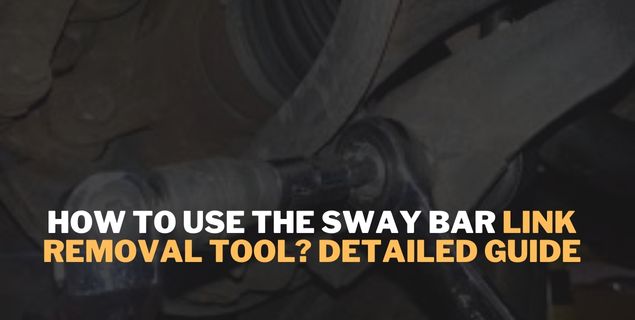Discover the importance of timely sway bar link replacement for a smoother, safer ride. Learn to recognize signs like noise, poor handling, and visible wear. Upgrade your suspension system’s performance and enhance vehicle stability with our comprehensive guide.
What Does the Sway Bar End Link Removal Tool Do?
The sway bar end link removal tool serves a specific and vital purpose in the process of maintaining and repairing a vehicle’s suspension system. Sway bar end links play a crucial role in connecting the sway bar to the suspension components, ensuring stability and control during turns and maneuvers. The removal tool is designed to simplify and expedite the removal of these end links, making the overall suspension maintenance process more efficient. Let’s delve into the key functions and benefits of the sway bar end link removal tool:
Facilitates Easy Disassembly:
The primary function of the sway bar end link removal tool is to simplify the disassembly of sway bar end links. These links are often secured with nuts or bolts that can be challenging to remove due to factors like rust and corrosion. The removal tool is crafted with features that provide enhanced leverage and grip, making the loosening and removal of these components more accessible.
Minimizes Physical Strain:
The design of the removal tool is ergonomic, minimizing the physical strain on the person performing the maintenance. Its leverage mechanics enable the user to apply controlled force without exerting excessive effort, reducing the risk of fatigue or injury during the removal process.
Prevents Damage to Components:
Traditional methods of removing sway bar end links, such as using standard wrenches or pliers, may result in damage to the links or surrounding components. The removal tool is specifically engineered to securely grip the nuts or bolts without causing distortion or harm to the end links, ensuring a smooth and damage-free removal process.
Time and Cost Efficiency:
The efficiency of the sway bar end link removal tool translates to time and cost savings. The tool’s effectiveness in swiftly removing end links reduces the overall labor time required for suspension maintenance or repairs. This is particularly beneficial for professional mechanics and DIY enthusiasts looking to optimize their time and resources.
Versatility and Compatibility:
Sway bar end link removal tools are designed to be versatile and compatible with a variety of vehicle makes and models. Their adjustable features and standardized fittings make them suitable for a wide range of applications, providing users with a reliable solution for different suspension systems.
Enhanced Safety:
By offering a controlled and efficient means of removing sway bar end links, the removal tool contributes to overall safety in the maintenance process. Reduced physical strain and the prevention of component damage not only make the task safer for the person performing it but also contribute to the integrity of the vehicle’s suspension system.
When Should You Replace the Sway Bar Link?
Knowing when to replace the sway bar links is crucial for maintaining the optimal performance and safety of a vehicle’s suspension system. Sway bar links play a key role in stabilizing the vehicle during turns and maneuvers, and replacing them at the right time is essential to prevent handling issues and potential safety concerns. Here are several signs indicating that it’s time to replace the sway bar links:
Excessive Noise:
Unusual noises, such as clunking, rattling, or knocking sounds, especially when driving over bumps or making turns, can be indicative of worn or damaged sway bar links. These noises suggest that the links may have loose or worn-out components that need attention.
Uneven Tire Wear:
If you notice uneven tire wear, particularly on the edges of the tires, it could be a sign of an imbalance in the suspension system. Worn sway bar links may contribute to this issue, as they play a role in maintaining proper alignment and weight distribution.
Poor Handling or Steering Response:
Worn or damaged sway bar links can result in compromised handling and responsiveness while steering. If you experience increased body roll, excessive swaying, or a feeling of instability during turns, it may be an indication that the sway bar links need replacement.
Visible Damage or Wear:
Inspect the sway bar links visually for any signs of damage, corrosion, or excessive wear. If you notice cracked or deteriorated rubber bushings, bent or damaged metal components, or signs of rust, it’s advisable to replace the sway bar links to ensure optimal performance.
Loose or Play in the Links:
Physically check the sway bar links for any play or looseness. If there is noticeable movement or play when you manually manipulate the links, it indicates that the components may be worn, and replacement is necessary to maintain the structural integrity of the suspension system.
Vehicle Tilt or Lean:
A vehicle that leans excessively to one side during turns or exhibits an uneven stance may have an issue with the sway bar links. This imbalance can affect the overall stability and handling of the vehicle, requiring prompt replacement of the faulty components.
Failure During Routine Inspection:
During regular maintenance inspections or when replacing other suspension components, it’s advisable to inspect the sway bar links. If there are signs of wear, damage, or any of the aforementioned issues, it is an opportune time to replace the links preventatively.
High Mileage:
As a preventative measure, consider replacing sway bar links if your vehicle has reached a high mileage. Over time, the constant stress and movement experienced by the suspension components can lead to wear, making proactive replacement a wise decision.
Conclusion
In conclusion, understanding when and how to replace sway bar links is essential for maintaining the overall performance, safety, and stability of your vehicle’s suspension system. Regular inspections, prompt attention to signs of wear or damage, and proactive replacement contribute to a smoother ride, improved handling, and enhanced driving experience. By prioritizing the health of your sway bar links, you ensure that your vehicle remains in optimal condition, ready to tackle the twists and turns of the road with confidence.

